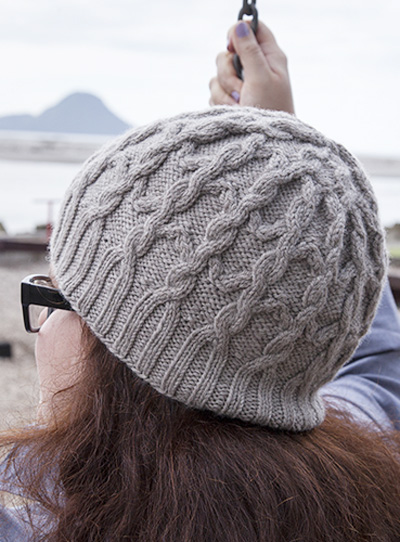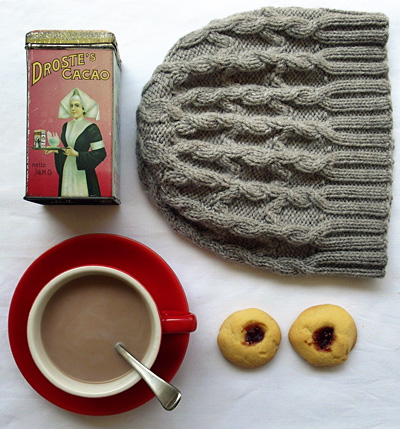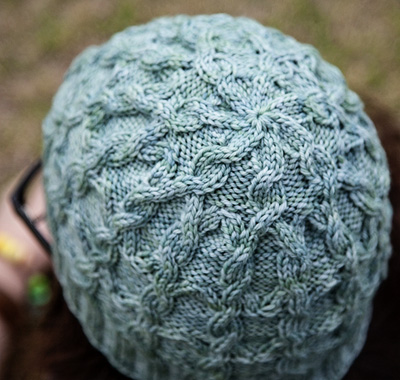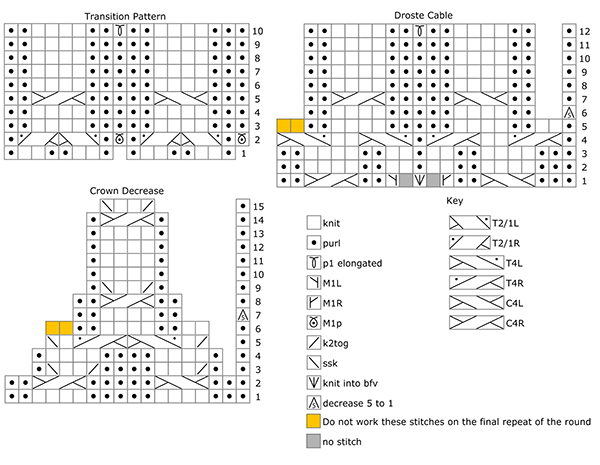|
|

A painting containing itself in miniature, a film within a film, a knitting pattern that looks like knitting: these are examples of the self-referential Droste effect. This hat is the result of a challenge I set myself. Could I come up with a cable pattern that looks like stockinette stitch? I found the final piece of the puzzle — a closed-ring cable technique — in Barbara G. Walker's Charted Knitting Designs. |
||
|
|
 |
Tweet
 |
|
|
||
|
SIZE |
 
|
|
FINISHED MEASUREMENTS |
|
MATERIALS Sea-green hat: Notions |
|
GAUGE |
|
PATTERN NOTES |
|
 knit into bfv: Knit into the back and front of the next stitch, then insert your left-hand needle behind the vertical strand in front of the two stitches just worked, and knit it through the back loop. 1 stitch increased to 3. Decrease 5 to 1: Slip the next 2 stitches knitwise, removing the marker if necessary. *Lift the second stitch on the left-hand needle over the first stitch and off. Now slip that first stitch to your right-hand needle and slip the second stitch on that needle over it. Return the first stitch on the right-hand needle to your left-hand needle and repeat from * once more. Replace marker if necessary, and purl the stitch. M1p: Insert left needle, from front to back, under the horizontal strand which lies between the stitch just knit, and the following stitch; then purl into the back of this loop. 1 stitch increased. T2/1L: Slip 2 stitches to cable needle and hold in front, p1, then k2 from cable needle.
Transition Pattern Droste Cable Pattern Crown Decreases Pattern |
|
DIRECTIONS 
With your smaller needles, using the Long Tail method (or your preferred cast-on method for beginning 2x2 ribbing), CO 112[128] stitches. Place marker, and join to work in the round. Ribbing round: [K2, p2] around. Body Next round: Work Droste Cable Pattern 7[8] times around. Work as set until all 12 rounds of Droste Cable Pattern are complete, and then work Rounds 1-11 once more.  Next round: Work Crown Decrease Pattern 7[8] times around. Work as set until Crown Decrease Pattern is complete, switching to needles for small circumference when piece gets too small for circular needle. 35[40] st rem when chart is complete. Setup for final Decrease: Round 1: K3, p1, [k4, p1] to last st, k1. |
|
FINISHING |
| ABOUT THE DESIGNER |
|
You can find Amy on Ravelry and at her blog, Baroque Purls. |
|
Pattern & images © 2015 Amy van de Laar. Contact Amy |





